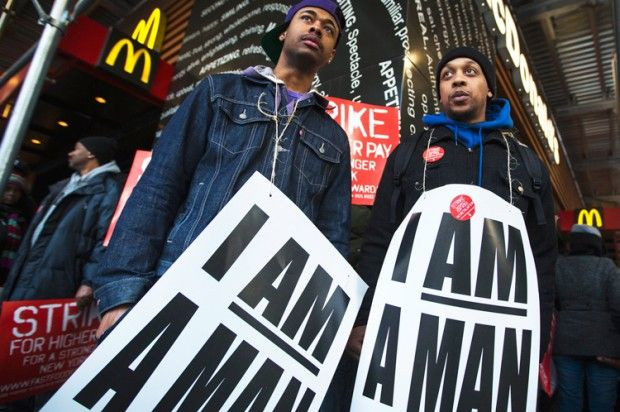Fast Food Workers Strike In NYC, Chicago, Seeking $15 An Hour

Thousands of fast-food workers across the country have walked away from their jobs at McDonald's Corp. (NYSE:MCD) and Wendy’s Co. (NASDAQ:WEN), striking for higher wages. Pickets at the fast-food outlets say they are fighting to unionize and earn wages of $15 an hour, more than twice the federal minimum wage on which many employees struggle to live.
According to Reuters, workers in New York City, Chicago, St. Louis, Detroit, Kansas City, Milwaukee, and Flint, Mich., all joined the protests sponsored by Fast Food Forward on Monday. As many as 500 employees from restaurants like McDonald’s, Taco Bell and Wendy’s turned up for the New York City rallies alone.
Protesters say the fast-food chains simply do not provide wages high enough for workers to support themselves or their families. In response, they are asking for $15 an hour and the right to unionize and negotiate for better working conditions.
"Remaining silent is not an option because it's nearly impossible to survive on $7.25 an hour," Kareem Starks, a McDonald's worker in Brooklyn, told Reuters.
Reuters notes that the current federal minimum wage of $7.25 an hour is worth less than at many other points in American history due to rising inflation. Adjusted for inflation, the current minimum wage is worth 22 percent less than the 1968 minimum wage, which would be $9.27 in today’s money.
Congress last voted to raise the minimum wage in 2007, leading to the current federal minimum wage of $7.25. Before the 2007 hike, Congress had not raised the minimum wage in more than a decade. Recently, President Barack Obama attempted to launch a new bill raising the federal minimum wage to $9, but his efforts were dead on arrival in Congress.
Even McDonald’s itself virtually admitted that a full-time job at one of its locations isn’t enough to make ends meet. Recently, McDonald’s released a widely criticized “sample monthly budget” for its workers, showing that the average McDonald’s employee must depend on the income from a second job in order to meet their relatively small budget of $2,060 per month.
Many observers have noted a similarity between these fast food protests and the recent Occupy Wall Street movement, which, among other goals, attempted to shine a light on income disparity in the United States.
“With the Occupy movement and discussion about the 1 percent, people are much more aware about the increase in inequality,” Janet Currie, an economics and policy affairs professor at Princeton University, told Bloomberg in an interview. “There are a lot of people right at the top of the distribution who are doing better than that segment of the population has since the 1920s, and that’s driving a lot of the income inequality.”
© Copyright IBTimes 2024. All rights reserved.






















